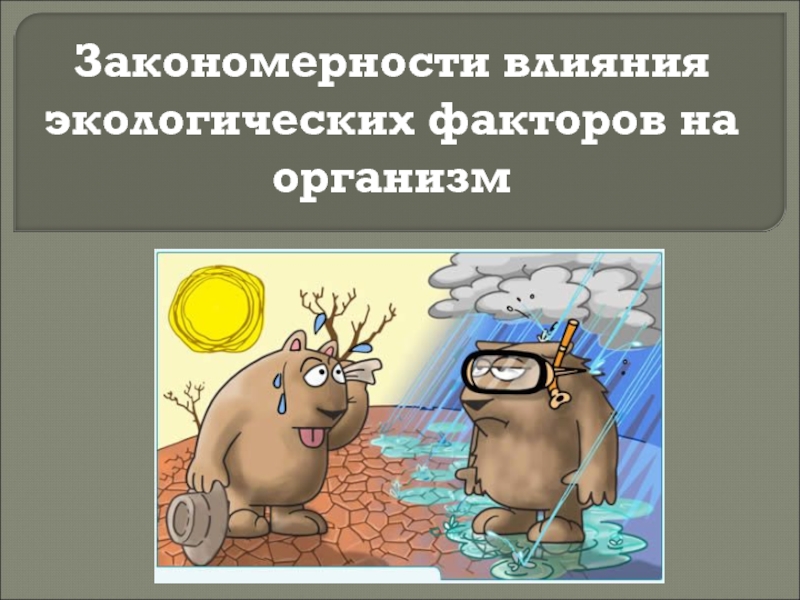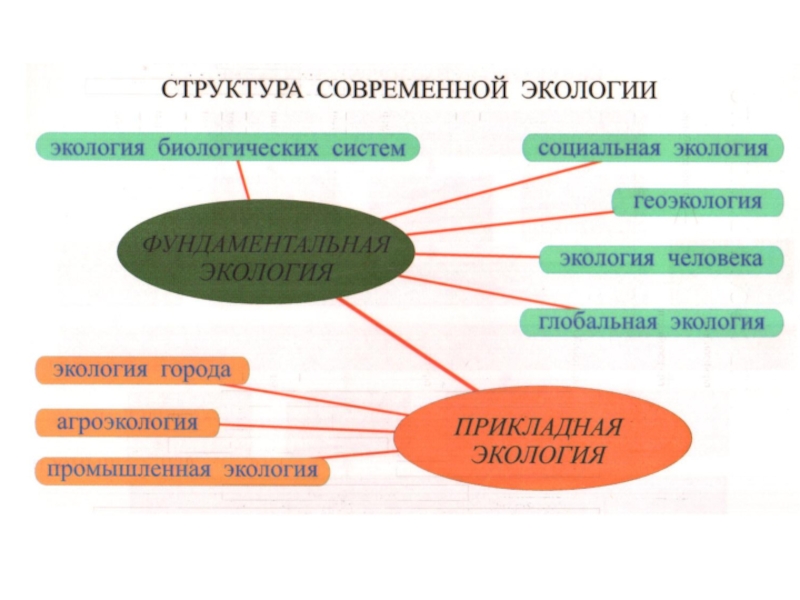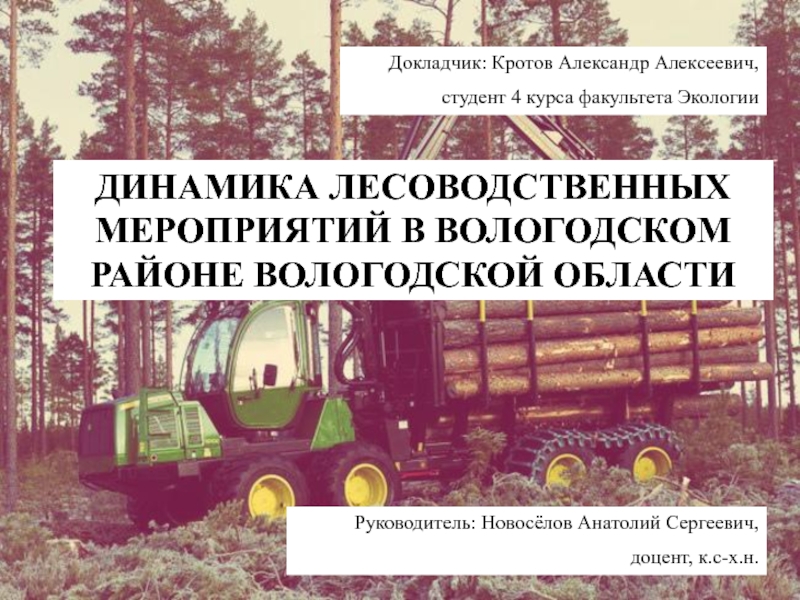- Главная
- Разное
- Дизайн
- Бизнес и предпринимательство
- Аналитика
- Образование
- Развлечения
- Красота и здоровье
- Финансы
- Государство
- Путешествия
- Спорт
- Недвижимость
- Армия
- Графика
- Культурология
- Еда и кулинария
- Лингвистика
- Английский язык
- Астрономия
- Алгебра
- Биология
- География
- Детские презентации
- Информатика
- История
- Литература
- Маркетинг
- Математика
- Медицина
- Менеджмент
- Музыка
- МХК
- Немецкий язык
- ОБЖ
- Обществознание
- Окружающий мир
- Педагогика
- Русский язык
- Технология
- Физика
- Философия
- Химия
- Шаблоны, картинки для презентаций
- Экология
- Экономика
- Юриспруденция
Test TPO 1. Timberline vegetation on mountains. (Section 1) презентация
Содержание
- 1. Test TPO 1. Timberline vegetation on mountains. (Section 1)
- 2. Set the timer to 20
- 3. Question 1 of 14
- 4. Question 2 of
- 5. Question 3
- 6. Question 4
- 7. Question 5
- 8. Question 6
- 9. Question 7
- 10. Question 8
- 11. Question 9
- 12. Question 10
- 13. Question 11
- 14. Question 12
- 15. Question 13
- 16. Question 14
- 18. Congratulations! You have completed this practice test.
- 19. RETURN D A B C C B
- 20. Are you sure you want to exit
- 21. Your answers will be saved with the
- 22. OK When your computer asks you if
- 23. OK When your computer asks you if
Слайд 2
Set the timer to 20 minutes before doing this test.
If you
Слайд 3
Question 1 of 14
gradual
complex
visible
striking
The world 【dramatic】 in the passage is closest
Слайд 4
Question 2 of 14
Where is the lower timberline mentioned in paragraph
In an area that has little water
In an area that has little sunlight
Above a transition area
On a mountain that has no upper timberline
Paragraph 1 is marked with ◆
Слайд 5
Question 3 of 14
Which of the following can be inferred from
Both are treeless zones.
Both mark forest boundaries.
Both are surrounded by desert areas.
Both suffer from a lack of moisture.
Paragraph 1 is marked with ◆
Слайд 6
Question 4 of 14
Paragraph 2 supports which of the following
They cannot grow in cold climates.
They do not exist at the upper timberlines.
They are less likely than evergreens to survive at the upper timberline.
They do not require as much moisture as evergreens do.
Paragraph 2 is marked with ◆
Слайд 7
Question 5 of 14
The word 【attain】 in the passage is closest
require
resist
achieve
endure
Слайд 9
Question 7 of 14
The word 【prone】 in the passage is closest
adapted
likely
difficult
resistant
Слайд 10
Question 8 of 14
According to paragraph 3, which of the following
Tree growth is negatively affected by the snow cover in valleys.
Tree growth is greater in valleys than on ridges.
Tree growth on ridges is not affected by high-velocity winds.
Tree growth lasts longer in those latitudes than it does in the tropics.
Paragraph 3 is marked with ◆
Слайд 11
Question 9 of 13
Which of the sentences below best expresses the
Because of their deformed shapes at high altitudes, trees are not likely to be seriously harmed by the strong winds typical of those altitudes.
As altitude increases, the velocity of winds increases, leading to a serious decrease in the number of trees found at high altitudes.
The deformed shapes of trees at high altitudes show that wind velocity, which increases with altitudes, can cause serious hardship for trees.
Increases wind velocity at high altitudes deforms the shapes of trees, and this may cause serious stress for trees.
Слайд 12
Question 10 of 14
In paragraph 4, what is the author’s
To argue that none of several environmental factors that are believed to contribute to that phenomenon do in fact play a role in causing it
To argue in support of one particular explanation of that phenomenon against several competing explanations
To explain why the primary environmental factor responsible for that phenomenon has not yet been identified
To present several environmental factors that may contribute to a satisfactory explanation of that phenomenon
Paragraph 4 is marked with ◆
Слайд 13
Question 11 of 14
The world 【prevalent】 in the passage is closest
predictable
widespread
successful
developed
Слайд 14
Question 12 of 14
According to paragraph 6, all of the following
Because they are low, they are less exposed to strong winds
Because they are low, the wind snow cover gives them more protection from the extreme cold.
In the equatorial mountains, they tend to be lower than in mountains elsewhere.
Their low growth form keeps them closer to the ground, where there is more heat than further up.
Paragraph 6 is marked with ◆
Слайд 15
Question 13 of 14
Look at the four squares [■]that indicate where
This explains how, for example, alpine cushion plants have been found growing at an altitude of 6,180 meters.
Where would the sentence best fit?
■ 1
■ 2
■ 3
■ 4
Слайд 16
Question 14 of 14
Directions: An introductory sentence for a brief summary
Answer Choices
To review passage. Click View Text
At the timberline, whether upper or lower, there is a profound change in the growth of trees and other plants.
●
●
●
Birch is one of the few species of tree that can survive in the extreme environments of the upper timberline.
There is no agreement among scientists as to exactly why plant growth is sharply different above and below the upper timberline.
The temperature at the upper timberline is probably more important in preventing tree growth than factors such as the amount of snowfall or the force of winds.
The geographical of an upper timberline has an impact on both the types of trees found there and their physical characteristics.
High levels of ultraviolet light most likely play a greater role in determining tree growth at the upper timberline than do grazing animals such as the ibex.
Despite being adjacent to the timberline, the alpine tundra is an area where certain kinds of low trees can endure high winds and very low temperatures.
Слайд 18Congratulations!
You have completed this practice test.
Save / exit the test
Review
Obtain answer keys
Слайд 19RETURN
D
A
B
C
C
B
B
A
C
D
B
C
4th square
The Geographical location of…
There is no agreement among…
The temperature at…
Слайд 20Are you sure you want to exit the test?
YES
NO
Exit the test.
Return to the last question and resume doing the test.
Слайд 21Your answers will be saved with the file.
Your answers will
Do you want to save your answers?
YES
NO





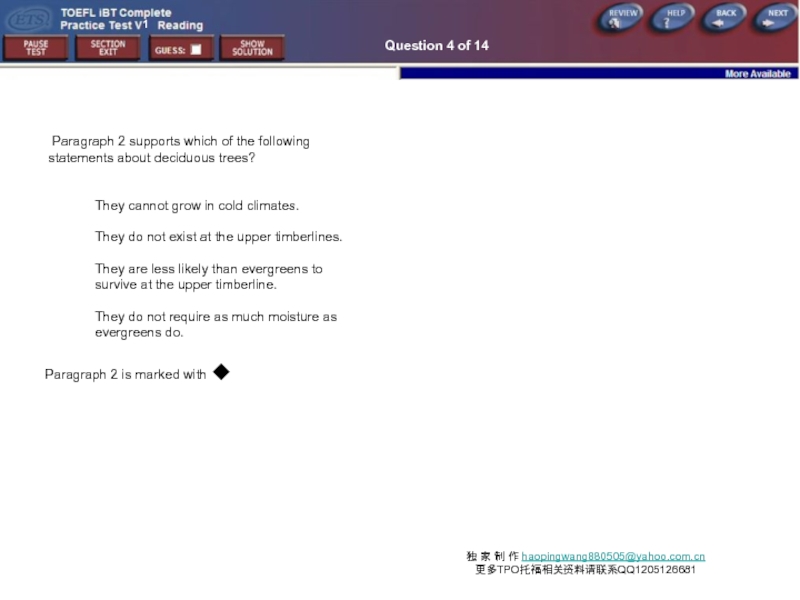





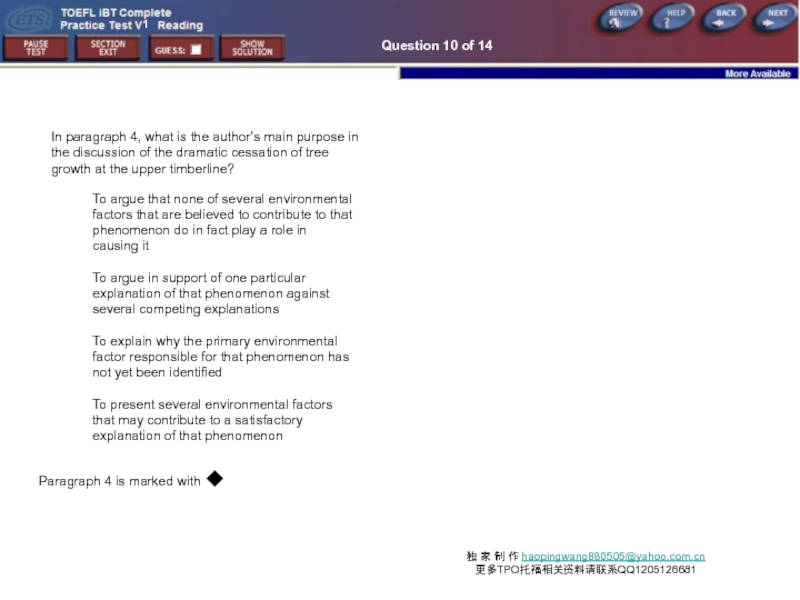


![Question 13 of 14Look at the four squares [■]that indicate where the following sentence could](/img/tmb/5/422072/e860c5c0a8899c113c01aa4aaa5a0b12-800x.jpg)









